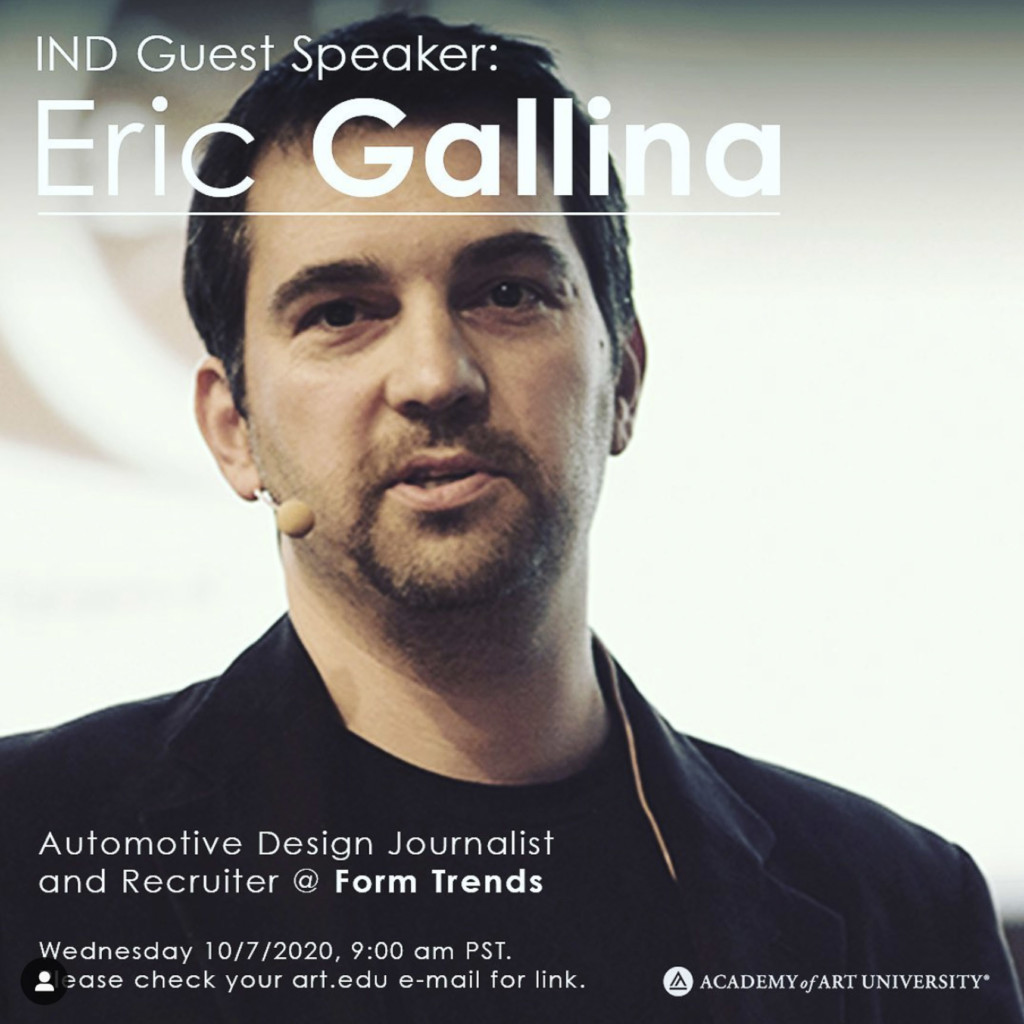By Nina Tabios
On Wednesday, Oct. 7, students from Academy of Art University’s School of Industrial Design (IND) logged on to Zoom to chat with automotive journalist and photographer Eric Gallina on how current events and trends may shape the cars and mobility of tomorrow.
Gallina’s talk took place as part of a series of online IND workshops and guest speakers that honed in on various aspects of design and the industry. Although he’s never designed a car, Gallina spent 15 years covering automotive design as a journalist, turning industry insight and his own expertise into articles for publications like Auto & Design Magazine, Car Design News, and now, his own multimedia platform, Form Trends.
Especially in light of the pandemic, Gallina’s grasp on the industry provided a new perspective for students who were wondering what was coming next.
“[This year] has not been good for anyone, certainly not the automotive industry,” Gallina said from his home in London. “Even before that, the automotive industry has had to pivot—and I think that’s the operative word for 2020 … The thing with design is there’s always a need for qualified people, people that are skilled at what it is that they do. But it’s changing.”

Led by IND Director Antonio Borja, the main question of the event was “What does the future look like for these students?” Gallina, who also does some consulting and recruiting through Form Trends, touched upon the importance of user experience and how consumer values around car ownership have shifted with the popularity of ridesharing. But when asked about the skillsets students should adopt, Gallina focused on the intangibles.
“Drawing that pretty sketch is going to get you in the door but, at the end of the day, you need to have critical thinking,” Gallina said. “You have to contribute ideas, they want to know you have longevity in what it is you can provide to that company. They want to know that you can think about certain ways to move a brand forward.”
Borja encouraged his students to ask questions and many of them were curious about how new developments, like electrification, were going to impact design and manufacturing.
“With electric cars, the engine is no longer being a big part of the design. Where the engine could’ve been is being used for something else and it changes the interior and exterior design entirely. What do you see happening to the automotive industry and how people are designing it?” asked Devin Willoner, a B.F.A. transportation student.
Gallina responded that the move toward electrification is due to mandates enforcing the need for cleaner vehicles driving around city centers. Because of this, Gallina thinks companies may play around with the mechanics of the car and may eventually rethink how vehicles look and function altogether.
“[I think] eventually car companies will lean more into creating a platform that can be built into what the user wants it to be,” Gallina said. “This opens up a lot of opportunities for designers to come out with truly innovative stuff and tell the story of a specific brand because they were able to make a car with a hell of a lot more space because of the miniaturization of those components.”
Sodium Na, also a transportation design student, wondered how technology could potentially replace designers in the studio. In our lifetime, Gallina replied, not any time soon.
“From a technology standpoint, I don’t think anything is going to replace a designer,” Gallina said. “Especially with the way things are going, you need a human touch. You still need somebody with some taste, and a computer algorithm isn’t just going to do it.”
The main difference, he continued, is the designer’s ability to turn their own lived experiences and perception into thoughtful concepts.
“Don’t be a follower, be the trendsetter,” Gallina said. “As a designer, people want to know you have ideas and you’re bringing some fresh creative thinking to the table. That’s what they’re looking for, that’s what they’re hungry for, but you have to show you understand what’s going to be involved.”
For Borja, it was refreshing to hear Gallina’s takes and observations on the automotive industry because it validated some of the decisions they’ve made within the department.
“The fact that he lives in Europe, I think makes him in many more ways attuned to what’s happening in North America,” Borja said. “As a designer, one of the most important things you can do that Eric touched on is just go out and gain new experiences so that you can gain a broader perspective on all of your work. And I think if you do that, that will help you become a more complete designer.”
